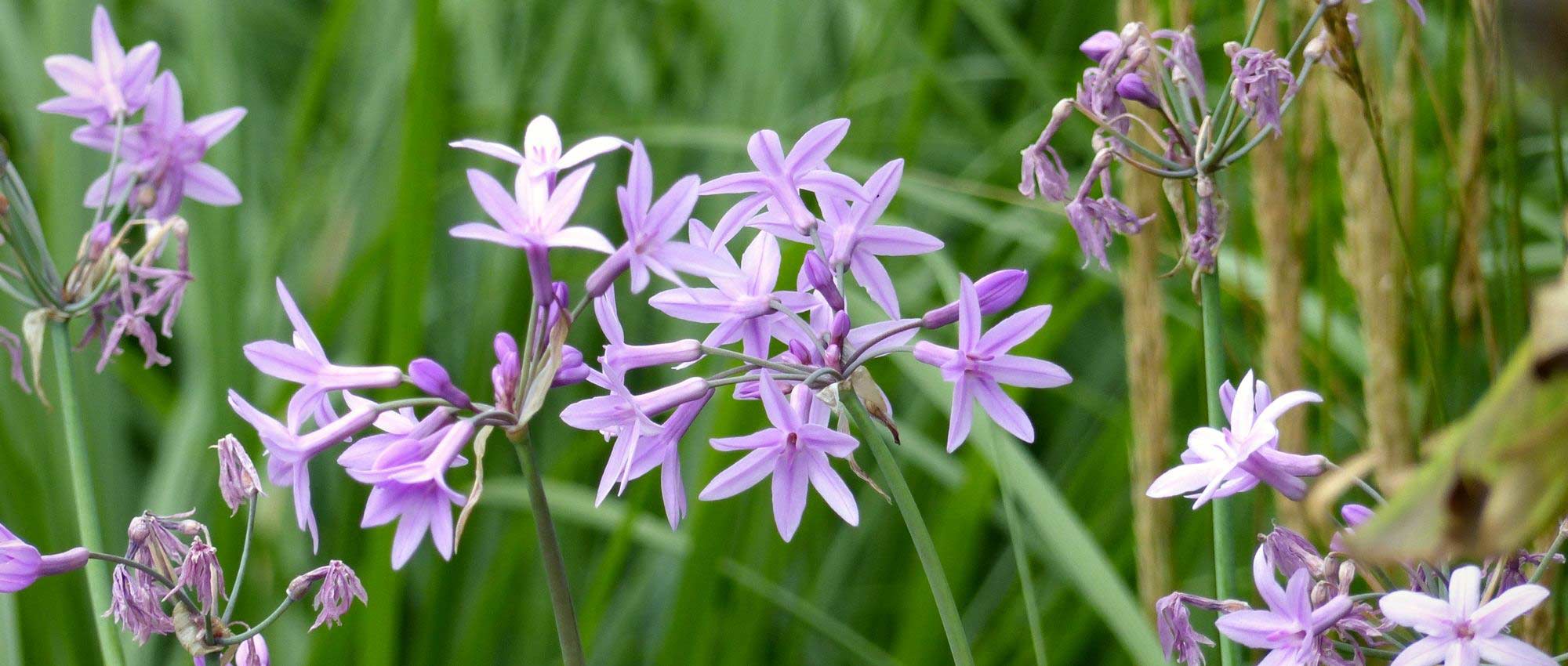
Tulbaghia: planting, growing and care
Contents
Tulbaghia in a nutshell
- Tulbaghia is a lovely bulbous perennial that flowers for a long time, from June–July through to October
- It then produces delicate lilac or white flowers, arranged in umbels
- Its fine, narrow leaves are also appreciated, usually green, sometimes variegated
- Flowers, leaves and bulbs are edible and have a garlicky flavour
- Tulbaghia thrives in full sun, in well-draining, fertile soil
A word from our Expert
Tulbaghia is a charming bulbous perennial native to South Africa. It has very narrow linear leaves that release a garlicky scent when crushed. Its delicate inflorescences, borne in umbels, consist of small mauve or white flowers. These flowers form an elongated tube that opens into a star of six thin petals. They are delicately scented. Flowering lasts a long time; it occurs in summer and continues into autumn. Tulbaghia leaves are generally green, but some varieties have foliage striate with white. Moreover, both flowers and leaves are edible. Their garlicky flavour is ideal to flavour dishes and salads.
Tulbaghia prefers full sun, in a well-draining, fertile and humus-bearing substrate. It needs watering in spring, during growth, then becomes more drought-tolerant. It tolerates temperatures down to -7 °C (even to -10 °C if planted in dry soil). You can protect it from cold by covering with a thick layer of mulch. Tulbaghia will thrive in a coastal garden. It is ideal in a rockery, as an edging, in a perennial bed, or in a pot. It is an undemanding perennial and easy to grow!
Botany
Botanical data
- Latin name Tulbaghia sp.
- Family Amaryllidaceae
- Common name Tulbaghia, South African garlic
- Flowering from June–July to October
- Height up to 60 cm
- Exposure full sun
- Soil type free-draining, fertile, fresh in spring
- Hardiness down to −7 °C (possibly −10 °C in dry ground)
Tulbaghia comprise 26 species of bulbous or rhizomatous plants native to South Africa. They grow in meadows and open habitats, sometimes in mountainous regions. They withstand down to −7 °C, even −10 °C when ground is dry and well drained.
Tulbaghia belongs to family Amaryllidaceae (former Alliaceae). This family includes notably Allium (garlic as well as onion, leek, chive, etc.), Agapanthus, Amaryllis, Narcissus, as well as snowdrops and lesser snowdrops. Many Amaryllidaceae are cultivated for ornamental interest, and most have bulbs or pseudobulbs that allow them to spend adverse season underground, in dormancy, to re-emerge in spring. As it belongs to same family, it is not surprising that Tulbaghia resembles a miniature Agapanthus, although flowers are smaller and leaves finer.
Tulbaghia was named after Ryk Tulbagh (1699–1771), Dutch governor of Cape of Good Hope in South Africa. In French, Tulbaghia is sometimes called “South African garlic”, while in English it is known as “Wild Garlic”. Species name T. violacea refers to flower colour.
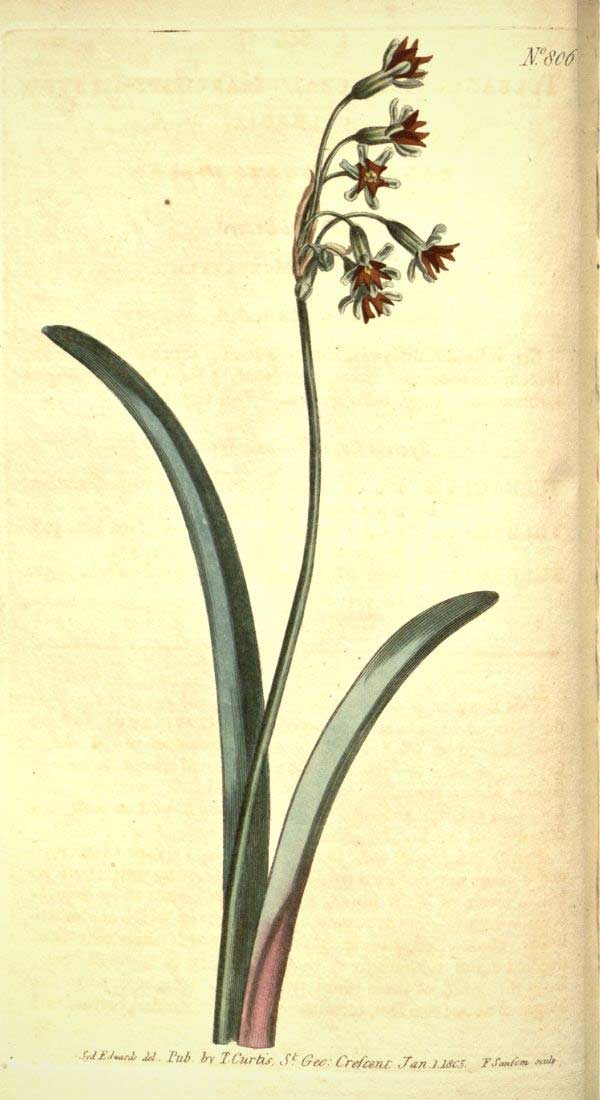
Tulbaghia alliacea: botanical illustration
Tulbaghia form elegant clumps with linear leaves resembling grass. From this foliage rise erect stems in summer, bearing delicate inflorescences at their tips. Tulbaghia reach 40–60 cm in height. They spread slowly by rootstocks, but never become invasive.
Tulbaghia offers a long flowering period, usually starting in July and often extending to October, depending on climate. Flowers are borne atop long erect stems, rising above the foliage. They are gathered in umbels of up to about 20 flowers. Flowering is reminiscent of Agapanthus but smaller and more delicate.
Flowers are generally pale violet to pink–lilac in hue. There are also white-flowered varieties. Variety ‘Purple Eye’ shows a stronger colour at flower centre. Species Tulbaghia alliacea is particularly unusual: it bears tubular flowers topped by a red–orange crown.
Tulbaghia flowers measure between 0.5 and 2 cm long and are star-shaped and fairly delicate. They consist of six fused tepals, extended into a tube at the base. Flowers of Tulbaghia simmleri resemble small daffodils.
Flowers are edible and can be used to garnish salads, for example. Their taste recalls garlic.
Tulbaghia flowers release a delicate scent (notably in evening). They are melliferous and attract pollinating insects. Tulbaghia simmleri, sometimes called T. fragrans, has more fragrant flowers than other species.

Tulbaghia flowering! Tulbaghia violacea ‘Variegata’ (photo Wouter Hagens), Tulbaghia simmleri ‘Alba’ (photo Vahe Martirosyan), and Tulbaghia violacea (photo Krzysztof Ziarnek)
Leaves are green, sometimes greyish, long and narrow. They strongly resemble grass leaves. They usually measure 10–30 cm long, sometimes up to 60 cm (in T. simmleri, for example). Leaves of variety ‘Silver Lace’ are notable for white striations.
Foliage is semi-evergreen in mild climates, deciduous when grown under cold climates.
If leaves are crushed, they release garlic scent. They are edible and indeed taste garlicky. Chop finely and add to raw-vegetable salads.
Tulbaghia has fleshy roots and rootstocks by which it spreads. However, it never becomes invasive.
Fruits are triangular capsules, about 1 cm long, which open when ripe to release small black seeds. Tulbaghia is capable of self-seeding freely in garden.

Foliage of Tulbaghia violacea ‘Variegata’ and Tulbaghia simmleri, and fruits (capsules) of Tulbaghia violacea (photos Wouter Hagens / Leonora Enking / El Grafo)
Read also
10 summer bulbs to plant in springMain varieties of Tulbaghia
Most popular varieties
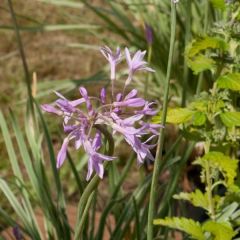
Tulbaghia violacea Silver Lace - Society Garlic
- Flowering time June to November
- Height at maturity 50 cm
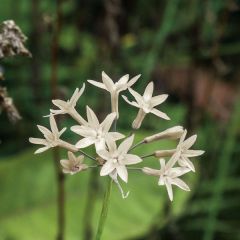
Tulbaghia fragrans Alba
- Flowering time July to October
- Height at maturity 50 cm
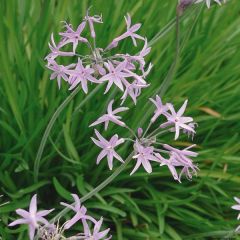
Tulbaghia cominsii Violacea - Society Garlic
- Flowering time July to November
- Height at maturity 55 cm
Discover other Tulbaghia
View all →Available in 0 sizes
Available in 1 sizes
Available in 2 sizes
Available in 2 sizes
Available in 2 sizes
Available in 3 sizes
Available in 2 sizes
Available in 1 sizes
Available in 2 sizes
Available in 1 sizes
Planting
Where to plant?
Tulbaghia will prefer to be planted in full sun, as good light encourages its flowering. However, if living in southern France, it can be planted in partial shade, while in the northern half of the country planting in full sun is preferable.
Tulbaghia prefers well-drained, fairly sandy soil, where moisture does not stagnate, otherwise its bulb and roots may rot. If soil is heavy and clayey, better to plant in a pot. It tolerates cold much better when grown in dry, well-drained soil. Tulbaghia also appreciates fertile, humus-bearing soils. It is not very sensitive to soil pH, tolerating acidic and calcareous soils.
Tulbaghia is ideal in seaside gardens, as it tolerates sea spray and wind very well. It fits perfectly into a Mediterranean-style garden alongside oleanders, lavenders and palms. It will find a place in a perennial border, an edging, a rockery or a pot.
When to plant?
We recommend planting Tulbaghia in spring, around May. However, planting in late summer to early autumn is also possible, especially in regions with mild climate.
How to plant?
Planting bulbs in open ground:
Flowers of Tulbaghia being quite small and delicate, we recommend planting a large number of bulbs together to obtain an attractive mass display. Tulbaghia produce a better visual effect when planted in groups rather than individually.
- Start by cultivating soil to loosen it. You can add well-rotted compost to enrich it, and coarse sand for drainage.
- Dig planting holes and place bulbs in them. Bulbs should be buried about 3 cm deep and spaced roughly 20 cm apart.
- Cover with soil and press down lightly.
- Water generously.
We recommend continuing to water regularly in the weeks following planting.
Planting in pots:
- Choose a pot and place a drainage layer at the bottom, for example small gravel or clay pebbles.
- Fill pot with a mix of potting compost, garden soil and coarse sand.
- Plant Tulbaghia bulbs and cover with substrate. They should be placed about 3 cm deep.
- Press down lightly.
- Water abundantly.
Place pot in a sunny spot, and remember to water regularly.
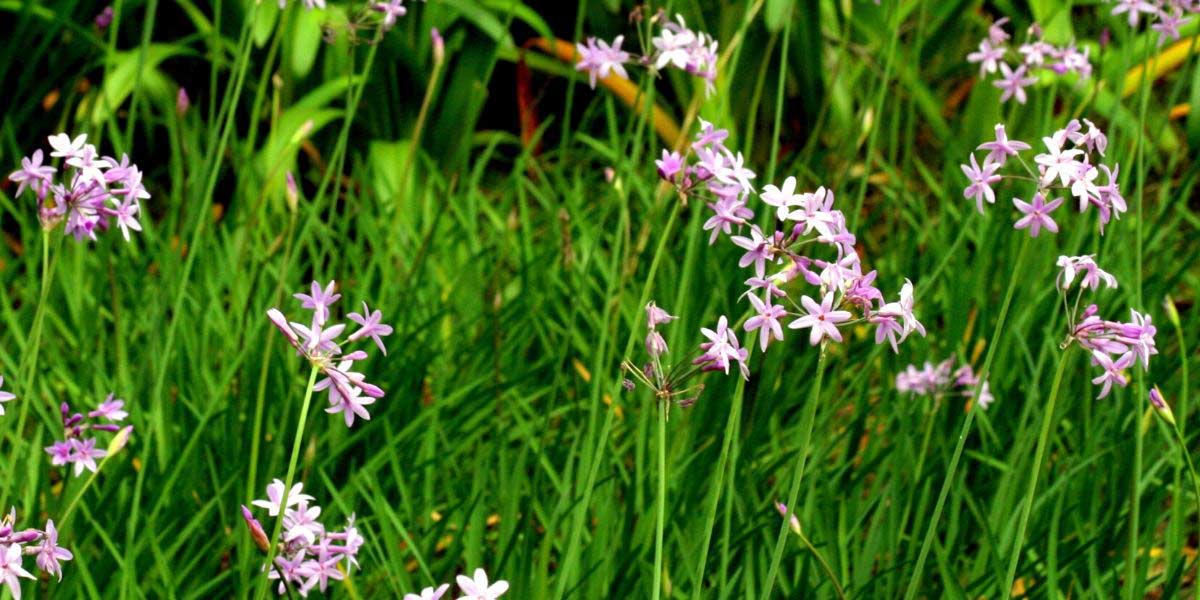
Tulbaghia violacea (photograph by Manuel Martín Vicente)
Care
In open ground :
Tulbaghia needs cool soil in spring; do not hesitate to water regularly if it doesn’t rain. Then, in summer, when it is in flower, it is much more drought-resistant. You can therefore reduce watering in summer, autumn and winter.
When you see them, you can remove faded flowers and damaged leaves. However, it is also useful to leave some faded flowers to allow the plant to self-seed. In autumn, we recommend cutting clumps back to about 4 centimetres above soil. If you live in a cold region, apply a thick layer of mulch (5–6 cm thick) on the stump to insulate it from cold during winter. Tulbaghia tolerates cold less well if soil tends to retain water.
You can divide Tulbaghias every three to four years. This rejuvenates clumps, restores vigour and at the same time encourages flowering.
Tulbaghia is not susceptible to diseases and pests; conversely, its garlic scent repels aphids! Similarly, the plant appears to secrete fungicidal substances, which therefore prevent development of fungal diseases. Occasionally, however, snails or slugs may eat Tulbaghia foliage.
In pots :
If you grow Tulbaghia in pots, you will need to water more frequently than in open ground. Indeed, the substrate dries out much faster when the plant is in a pot. Ensure Tulbaghia does not lack water in spring, and continue to water from time to time during summer. We also recommend adding some slow-release fertiliser. Likewise, it is preferable to repot it every three years.
Potted Tulbaghias can be brought in for winter, for example into a frost-free cold frame. Temperature should not be too high, as the bulb needs a cool environment during winter.
Propagation
Dividing clumps
You can divide Tulbaghia clumps in spring. Wait at least three years of cultivation before dividing, as these perennials do not like to be disturbed or transplanted. Division does, however, rejuvenate clumps and give them more room.
- Lift a large, well-developed clump at least three years old
- Separate it into several sections, ensuring each part retains roots
- We recommend cutting foliage back by half
- Prepare soil at new location, or prepare a pot with potting mix
- Replant in ground or in pot
- Water generously
After dividing, wait at least two years for Tulbaghia to start flowering again.
Sowing
You can sow seeds as soon as they are ripe, then place pots under cold frame. It is also possible to sow in spring.
- Prepare a pot with potting compost mixed with sand
- Sow seeds on surface
- Cover with a thin layer of potting mix, then press lightly
- Water with a fine mist
- Place pot in bright spot, out of direct sun, preferably under cold frame
As soon as seedlings are large enough to handle, repot them into individual pots. Wait one year before planting them out in garden.
Association
Tulbaghia is a small versatile perennial that will fit into many garden styles. Generally, we recommend planting it in large groups rather than alone to create a massed effect.
You can, for example, integrate it into a Mediterranean garden. Plant it with lavender, rosemary, agaves… Tulbaghias wonderfully accompany flowering of agapanthus, as they have a similar shape (umbel flowering) and comparable colours. If you want to include trees or bushes, choose, for example, oleanders, palms, fig trees or arbutus. Also consider citrus trees. If you live near the sea, this Mediterranean garden style will suit Tulbaghia perfectly — it tolerates sea spray and wind very well!
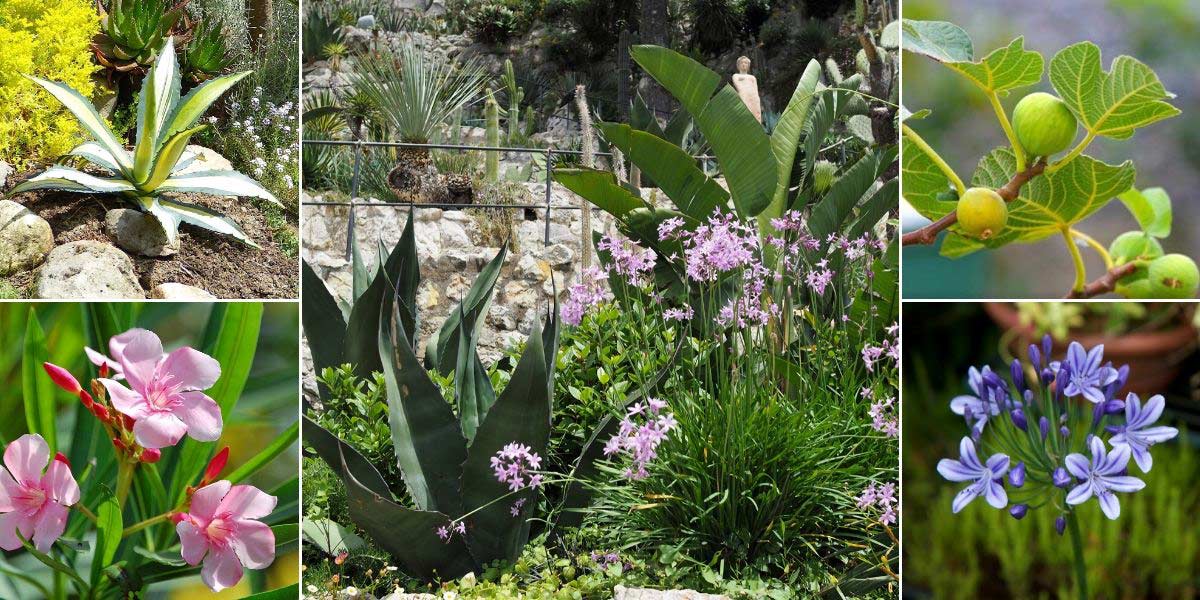
You can easily include Tulbaghia in a Mediterranean-style garden! Agave mediopicta ‘Lutea’ / Oleander (photo Challiyan) / Tulbaghia, agaves and strelitzia / Fig tree / Agapanthus
Tulbaghia can also be used in a rock garden. Create an elevated bed in full sun with large rocks and a free-draining substrate (additions of gravel, coarse sand, etc.). Place small sempervivums and sedums between the stones, and make use of hardy geraniums, Stachys byzantina and Campanula muralis.
Tulbaghia will also find a place in borders. You can plant it with perennials that have colourful flowers. It pairs perfectly with ornamental grasses: Carex, Stipa, fescues, etc. You can also associate Tulbaghia with agapanthus or with the blue‑mauve flowers of certain Lamiaceae: salvias, nepeta, lavender, Phlomis tuberosa…
Finally, you can also plant it in the vegetable garden. Its garlic scent has the advantage of repelling aphids! It appears to have a beneficial effect on carrots and beetroot, while it is better to plant it away from peas and beans. As its flowers, leaves and bulbs are edible, feel free to plant it with other herbs. You can harvest its leaves from time to time, chop them finely and add them to salads to enjoy their garlicky flavour.
Useful resources
- Discover our range of Tulbaghias
- Discover our tips to to grow Tulbaghia in a pot
- Find ideas to pair Tulbaghia
- To accompany Tulbaghia in the garden: 10 summer bulbs to plant in spring
- Discover 7 sun-loving perennials with long flowering periods
- Tulbaghia is edible! Discover how to use Tulbaghia in cooking
Frequently asked questions
-
My Tulbaghia are not flowering, or are flowering very little. Why?
Check that conditions suit them: an overly shaded location, for example, harms flowering. They will produce more flowers if they benefit from direct sunlight. You can also give them a little fertiliser to encourage flowering. In addition, if you have just planted or divided them, they may take several years to establish properly and start flowering. Be patient.
-
Can I leave bulbs outside for the winter?
Yes, if your soil is well drained and you do not live in an area that is too cold. In dry soil, Tulbaghia can tolerate temperatures down to -10 °C. You can also protect it by placing a layer of mulch over the stump in autumn. However, if your Tulbaghia are in pots, it may be wise to move them into an unheated frost-free shelter and put them back out the following spring.
- Subscribe!
- Contents
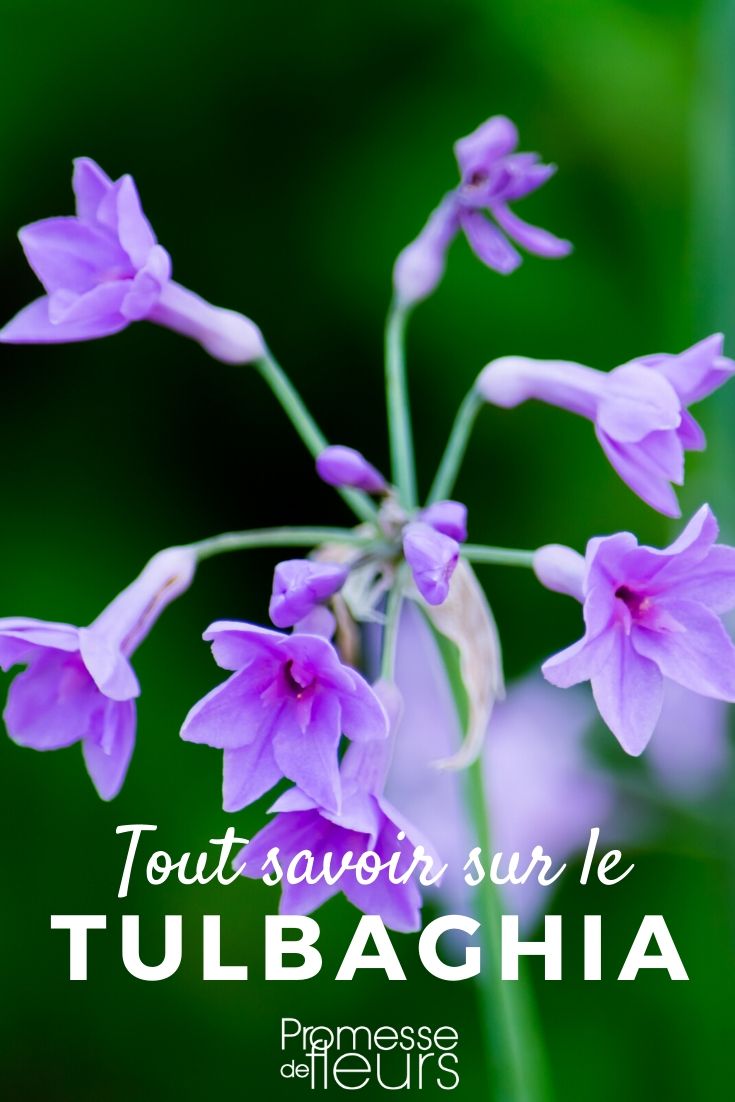































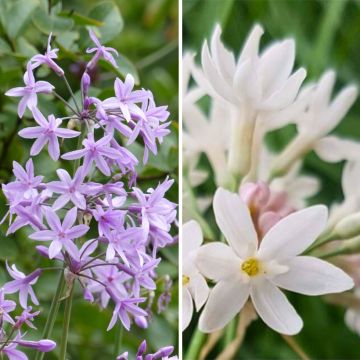

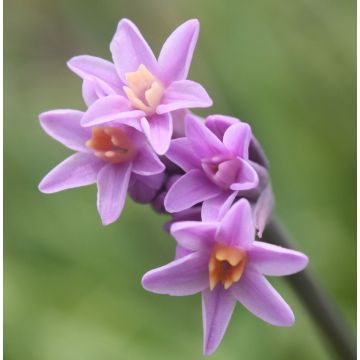
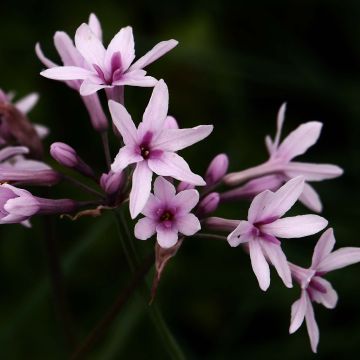
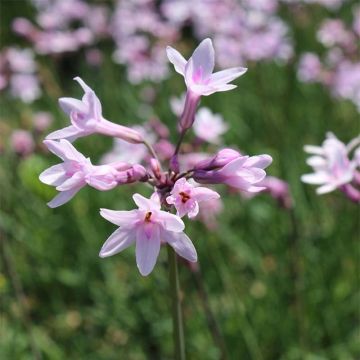


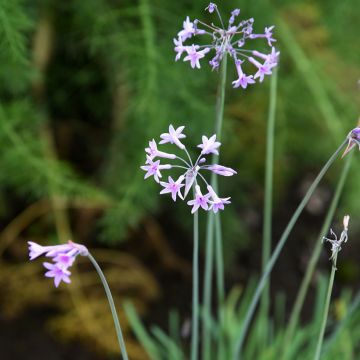
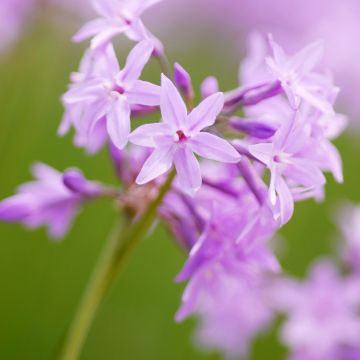

Comments